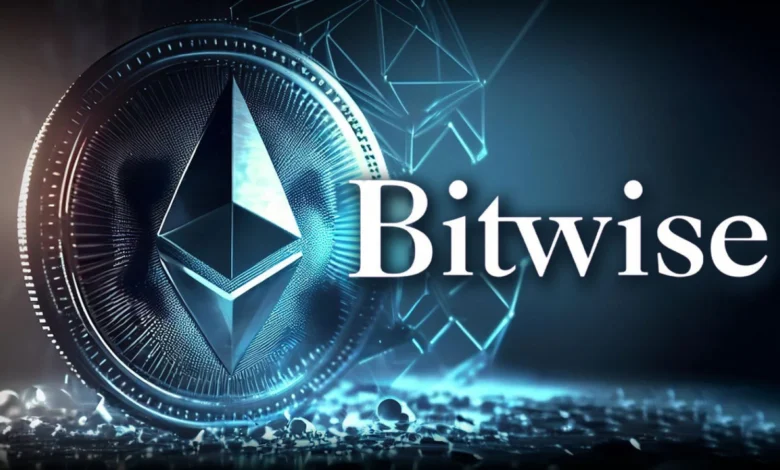DTCC Lists Bitwise Chainlink ETF CLNK Launch Imminent
DTCC's listing of Bitwise Chainlink ETF CLNK signals potential approval. Learn what this means for crypto investors and LINK holders.

Depository Trust and Clearing Corporation (DTCC) has reportedly listed the Bitwise Chainlink ETF under the ticker symbol ‘CLNK,’ a move that typically precedes the official launch of exchange-traded funds in traditional markets. This development has sparked considerable excitement among cryptocurrency enthusiasts and institutional investors alike, as it represents another step toward mainstream adoption of digital assets through regulated investment vehicles.
The listing of the Chainlink ETF in the DTCC’s database is particularly significant because it comes at a time when the cryptocurrency market is witnessing unprecedented institutional interest. Following the successful launches of Bitcoin and Ethereum spot ETFs, Bitwise Chainlink ETF CLNK: the industry has been anticipating which digital asset would be next to receive this level of regulatory acceptance. Chainlink, with its unique position as a decentralised oracle network that powers smart contracts across multiple blockchain platforms, has emerged as a strong contender for ETF approval.
Understanding the implications of this listing requires a comprehensive examination of what it means for investors, the broader cryptocurrency market, and the future of blockchain technology integration into traditional finance. This development signals that Bitwise Asset Management, a prominent digital asset manager, is moving forward with plans to offer investors exposure to Chainlink through a regulated fund structure, potentially opening the door for retirement accounts and institutional portfolios to gain access to this innovative technology.
The DTCC Listing Process
The Depository Trust and Clearing Corporation serves as the backbone of the American financial markets, processing trillions of dollars in securities transactions annually. When a new security or fund appears in the DTCC’s database, it indicates that the infrastructure is being prepared to support trading, clearing, and settlement of that instrument. This administrative step is essential before any ETF can begin trading on major exchanges.
The appearance of the Bitwise Chainlink ETF in the DTCC system suggests that regulatory approvals may be progressing through the necessary channels. While a DTCC listing doesn’t guarantee immediate approval from the Securities and Exchange Commission, it demonstrates that the application has advanced to a stage where market infrastructure providers are making technical preparations. This procedural milestone has historically been followed by formal approval announcements within weeks or months, though timelines can vary depending on regulatory review processes.
For cryptocurrency enthusiasts tracking the evolution of digital asset investment products, DTCC listings have become an important indicator of potential launches. The process involves coordination between fund sponsors, custodians, authorised participants, and market makers to ensure that the ETF can function smoothly once trading commences. The fact that these preparations are underway for a Chainlink-focused investment vehicle underscores the growing institutional recognition of the oracle network’s importance in the blockchain ecosystem.
What Makes Chainlink Unique in the Crypto Space
Chainlink occupies a distinctive position within the cryptocurrency landscape that sets it apart from purely monetary tokens like Bitcoin or platform tokens like Ethereum. As a decentralised oracle network, Chainlink serves a critical infrastructure function by connecting smart contracts with real-world data, external APIs, and traditional payment systems. This functionality addresses one of the fundamental limitations of blockchain technology: the inability of smart contracts to natively access information that exists outside their blockchain.
The LINK token, which would presumably be the underlying asset for the Bitwise ETF, operates as the economic incentive mechanism within the Chainlink network. Node operators stake LINK tokens as collateral to provide data feeds, and they earn LINK as payment for accurately delivering information to smart contracts. This creates a cryptoeconomic system where the token has utility beyond speculation, as it’s essential for the network’s security and functionality.
Chainlink’s technology has been integrated into hundreds of blockchain projects across decentralised finance, gaming, insurance, and supply chain management. Major enterprises, including Google Cloud, Oracle, and SWIFT, have partnered with or utilised Chainlink’s services, demonstrating the technology’s ability to bridge the gap between blockchain innovation and enterprise adoption. This real-world utility and institutional acceptance make Chainlink an attractive candidate for an ETF structure, as it offers investors exposure to a fundamental building block of blockchain infrastructure rather than just another cryptocurrency token.
Bitwise’s Track Record in Cryptocurrency ETF Innovation
Bitwise Asset Management has established itself as a pioneer in the cryptocurrency investment product space, consistently pushing the boundaries of what’s possible in regulated digital asset funds. The firm was among the first to file for a Bitcoin ETF years before such products were approved, demonstrating foresight and commitment to bringing institutional-grade cryptocurrency investment vehicles to market.
The company’s existing suite of cryptocurrency index funds and ETFs has garnered significant assets under management, reflecting investor confidence in Bitwise’s approach to digital asset investment. Their methodology emphasises security, regulatory compliance, and transparent operations—factors that are particularly important when dealing with the complexities of cryptocurrency custody and valuation. By selecting Chainlink as the focus of their latest ETF filing, Bitwise is signalling its belief that oracle networks represent the next frontier in mainstream cryptocurrency investment.
Bitwise’s decision to pursue a Chainlink ETF also reflects a strategic assessment of where the cryptocurrency market is heading. Rather than simply following the path of Bitcoin and Ethereum ETFs, the firm is identifying tokens with unique utility and essential infrastructure functions. This approach could appeal to investors seeking diversification beyond the largest cryptocurrencies while still maintaining exposure to assets with proven technology and adoption metrics.
Regulatory Landscape for Cryptocurrency ETFs
The regulatory environment for cryptocurrency exchange-traded funds has evolved dramatically over the past several years. After years of rejections, the Securities and Exchange Commission finally approved spot Bitcoin ETFs in January 2024, followed by spot Ethereum ETFs later that year. These approvals represented a watershed moment for the industry, as they acknowledged that cryptocurrency investment products could meet the regulatory standards for investor protection and market integrity.
The SEC’s approval framework has focused on several key criteria, including market surveillance mechanisms, custodial arrangements, liquidity, and the potential for manipulation. For a Chainlink ETF to receive approval, Bitwise would need to demonstrate that these standards can be met for LINK tokens in the same way they have been for Bitcoin and Ethereum. This includes showing adequate market depth, reliable pricing mechanisms, and robust custody solutions.
One advantage that Chainlink may have in the regulatory review process is its established track record of institutional partnerships and enterprise adoption. Unlike many cryptocurrency tokens that exist primarily for speculative purposes, Chainlink serves a clear functional role in blockchain infrastructure. This utility-driven purpose could strengthen the case for regulatory approval, as it demonstrates genuine demand from projects building on blockchain technology rather than purely speculative interest.
Market Implications: Bitwise Chainlink ETF CLNK
The potential launch of a Bitwise Chainlink ETF could have far-reaching implications for both LINK token markets and the broader cryptocurrency investment landscape. Historically, ETF approvals have catalysed significant price movements in the underlying assets, as they provide new avenues for institutional and retail capital to enter the market. Bitwise Chainlink ETF CLNK: The introduction of Bitcoin spot ETFs, for example, brought billions of dollars in new investment into the cryptocurrency over the subsequent months.
For Chainlink specifically, an ETF launch could dramatically expand the investor base beyond cryptocurrency-native participants. Traditional investors who maintain brokerage accounts but may be uncomfortable with cryptocurrency exchanges would gain straightforward access to LINK exposure through a familiar investment vehicle. This accessibility factor could drive sustained demand and potentially reduce volatility as a more diverse set of market participants engage with the asset.
The listing also sends a signal to other cryptocurrency projects and fund managers that the path to ETF approval may be widening beyond just Bitcoin and Ethereum. If Chainlink successfully obtains approval, it could open the floodgates for ETF applications covering other prominent cryptocurrencies with strong use cases and institutional adoption. This progression would represent another step toward the normalisation of cryptocurrency investment within traditional portfolio construction frameworks.
Technical Considerations for ETF Structure
Creating a cryptocurrency ETF involves numerous technical considerations that extend beyond simply purchasing and holding the underlying tokens. The Bitwise Chainlink ETF would need to establish secure custody arrangements, potentially partnering with qualified custodians who can safeguard LINK tokens according to institutional standards. This custodial infrastructure must protect against both cyber threats and operational risks while maintaining the liquidity necessary for ETF creation and redemption processes.
The ETF structure would also require mechanisms for accurate net asset value (NAV) calculation, which can be challenging in cryptocurrency markets that trade continuously across global exchanges. Bitwise would need to establish clear pricing methodologies that reflect fair market value while accounting for the idiosyncrasies of cryptocurrency market structure, including varying liquidity across different trading venues and the prevalence of 24/7 trading.
Additionally, the fund would need to implement systems for creation and redemption that allow authorised participants to efficiently arbitrage any divergence between the ETF’s market price and its NAV. This mechanism is essential for maintaining the tight tracking that investors expect from ETF products. For a cryptocurrency-based ETF, this process must account for settlement times on blockchain networks and the operational realities of moving digital assets between custodians, authorised participants, and the fund itself.
Investor Considerations and Portfolio Impact
For investors considering exposure to a Chainlink ETF, understanding the unique characteristics of the underlying asset is essential for making informed allocation decisions. Unlike Bitcoin, which functions primarily as a store of value and medium of exchange, or Ethereum, which serves as a platform for decentralised applications, Chainlink operates as middleware that enables smart contracts to function more effectively. This distinction means that LINK’s value proposition is tied to the growth of blockchain adoption and smart contract usage rather than serving as a direct alternative to traditional money or computing platforms.
The oracle network’s business model creates potential for steady demand regardless of broader cryptocurrency market sentiment, as blockchain projects require reliable data feeds to operate effectively. This characteristic could make a Chainlink-focused investment vehicle an interesting diversification option within a cryptocurrency allocation, offering exposure to infrastructure usage rather than just speculative positioning on cryptocurrency prices.
However, investors should also recognise that all cryptocurrency investments carry substantial volatility and risk. Despite Chainlink’s technological sophistication and enterprise partnerships, the LINK token has experienced significant price fluctuations throughout its history. An ETF structure provides convenience and regulatory oversight, but it doesn’t eliminate the inherent volatility of the underlying cryptocurrency market. Proper position sizing and risk management remain essential considerations for anyone adding cryptocurrency exposure to their portfolio.
The Broader Context of Blockchain Infrastructure Investment
The potential approval of a Bitwise Chainlink ETF reflects a maturing understanding of blockchain technology’s layered architecture and the various investment opportunities it presents. Early cryptocurrency investment focused almost exclusively on tokens that aspired to be currencies or stores of value. As the technology has evolved, however, the investment landscape has expanded to include platform tokens, decentralised finance protocols, and now infrastructure services like oracle networks.
Chainlink’s position in this ecosystem represents what some analysts call “picks and shovels” investment in the blockchain gold rush—rather than betting on which specific blockchain or application will dominate, investors can gain exposure to the infrastructure that many different projects require. This approach mirrors historical investment strategies in transformative technologies, where the companies providing essential services often captured value more reliably than those building end-user applications.
The oracle problem that Chainlink addresses is fundamental to blockchain’s practical utility. Without reliable connections to external data, smart contracts remain limited to information that already exists on the blockchain. By solving this challenge, Chainlink enables use cases ranging from decentralised insurance products that trigger payouts based on weather data to supply chain tracking systems that integrate IoT sensor information. An ETF focused on this infrastructure layer offers investors a way to participate in the growth of these diverse applications through a single investment vehicle.
Competitive Landscape and Market Positioning
While Chainlink is the most prominent decentralised oracle network, it operates in a competitive landscape with other projects offering similar functionality. Understanding this competitive environment is important for assessing the long-term investment case for a Chainlink ETF. Projects like Band Protocol, API3, and others have developed alternative approaches to the oracle problem, each with different technical architectures and market strategies.
Chainlink’s competitive advantages include its first-mover position, extensive network of node operators, and comprehensive suite of services that extend beyond simple price feeds. The network has built reputation systems, customizable oracle solutions, and specialised products like verifiable randomness functions and proof-of-reserve mechanisms. These innovations have helped Chainlink maintain market leadership despite emerging competition.
The total value secured by Chainlink’s oracle networks—meaning the aggregate value of smart contracts that rely on Chainlink data feeds—serves as a key metric for assessing adoption and market position. This figure has grown substantially over time, reflecting increasing trust in the network’s reliability and security. For investors considering a Chainlink ETF, monitoring these adoption metrics provides insight into whether the network is maintaining its competitive moat or facing erosion from alternative solutions.
Timing and Market Conditions
The timing of the DTCC listing for the Bitwise Chainlink ETF comes during an interesting period for both cryptocurrency markets and traditional finance. Following the approval of spot Bitcoin and Ethereum ETFs, there’s been a growing appetite among asset managers to expand the universe of cryptocurrency investment products available to mainstream investors. This favourable regulatory momentum could work in Chainlink’s favour as the SEC evaluates whether to approve additional cryptocurrency ETFs.
Market conditions in the cryptocurrency space have also evolved to support ETF structures better than in previous years. Custody solutions have matured significantly, with multiple qualified custodians now offering institutional-grade security for a wide range of digital assets. Market surveillance capabilities have improved, addressing one of the SEC’s long-standing concerns about cryptocurrency market integrity. These infrastructure improvements make it increasingly feasible for fund sponsors to meet regulatory requirements across different cryptocurrencies.
However, investors should recognise that regulatory approval timelines remain uncertain. The SEC has historically taken a cautious approach to cryptocurrency investment products, often requesting multiple rounds of revisions and clarifications before approving. While the DTCC listing suggests progress, it doesn’t guarantee that the Chainlink ETF will launch according to any particular timeline. Patience and realistic expectations are necessary when tracking these developments.
Conclusion
The listing of the Bitwise Chainlink ETF under the ticker symbol ‘CLNK’ in the DTCC’s database represents a significant milestone in the ongoing integration of cryptocurrency investments into traditional financial markets. This development suggests that institutional infrastructure is being prepared to support what could become the first ETF focused on decentralised oracle technology, offering investors convenient exposure to a critical piece of blockchain infrastructure.
Chainlink’s unique position as a middleware layer that enables smart contracts to interact with real-world data distinguishes it from other cryptocurrencies and potentially strengthens its case for regulatory approval. Bitwise Asset Management’s track record in cryptocurrency investment products adds credibility to the initiative, while favourable regulatory momentum following Bitcoin and Ethereum ETF approvals creates a conducive environment for expansion into additional digital assets.
For investors, a Chainlink ETF would provide regulated access to an infrastructure play within the cryptocurrency ecosystem, potentially offering different risk-return characteristics than pure monetary or platform tokens. However, substantial volatility and regulatory uncertainty remain inherent to all cryptocurrency investments, regardless of the wrapper in which they’re offered.
As the cryptocurrency investment landscape continues to evolve, the potential launch of a Chainlink ETF represents another step toward normalising digital asset exposure within diversified portfolios. Whether this particular product receives approval or not, the trend toward expanding cryptocurrency ETF offerings seems clear, reflecting growing institutional acceptance of blockchain technology’s role in the future of finance.
FAQs
Q: What does DTCC listing mean for the Bitwise Chainlink ETF?
A DTCC listing indicates that the operational infrastructure is being prepared to support the ETF’s trading, clearing, and settlement processes. While this is an important procedural step that typically precedes ETF launches, it doesn’t guarantee SEC approval.
Q: How is Chainlink different from Bitcoin or Ethereum?
Chainlink serves a fundamentally different purpose than Bitcoin or Ethereum within the blockchain ecosystem. While Bitcoin functions primarily as a store of value and Ethereum operates as a platform for decentralised applications, Chainlink provides oracle services that connect smart contracts with external data sources.
Q: Who is Bitwise Asset Management, and why are they significant?
Bitwise Asset Management is a cryptocurrency investment firm with a strong track record of creating institutional-grade digital asset products. The company was an early filer for Bitcoin ETF applications and has successfully launched various cryptocurrency index funds and investment vehicles.
Q: When might the Chainlink ETF actually launch?
The timing of potential approval and launch remains uncertain, as it depends on the SEC’s regulatory review process. Historically, cryptocurrency ETF applications have taken months or even years to receive approval, with the SEC often requesting multiple rounds of clarifications and amendments.
Q: Should investors wait for the ETF or buy LINK directly?
The choice between waiting for an ETF or purchasing LINK tokens directly depends on individual circumstances and preferences. ETFs offer convenience, regulatory oversight, and the ability to hold exposure in traditional brokerage and retirement accounts. However, direct token ownership provides immediate access and potentially lower costs, though it requires comfort with cryptocurrency.


